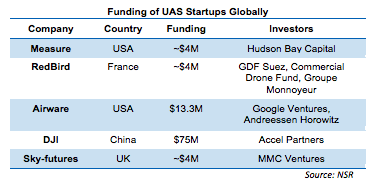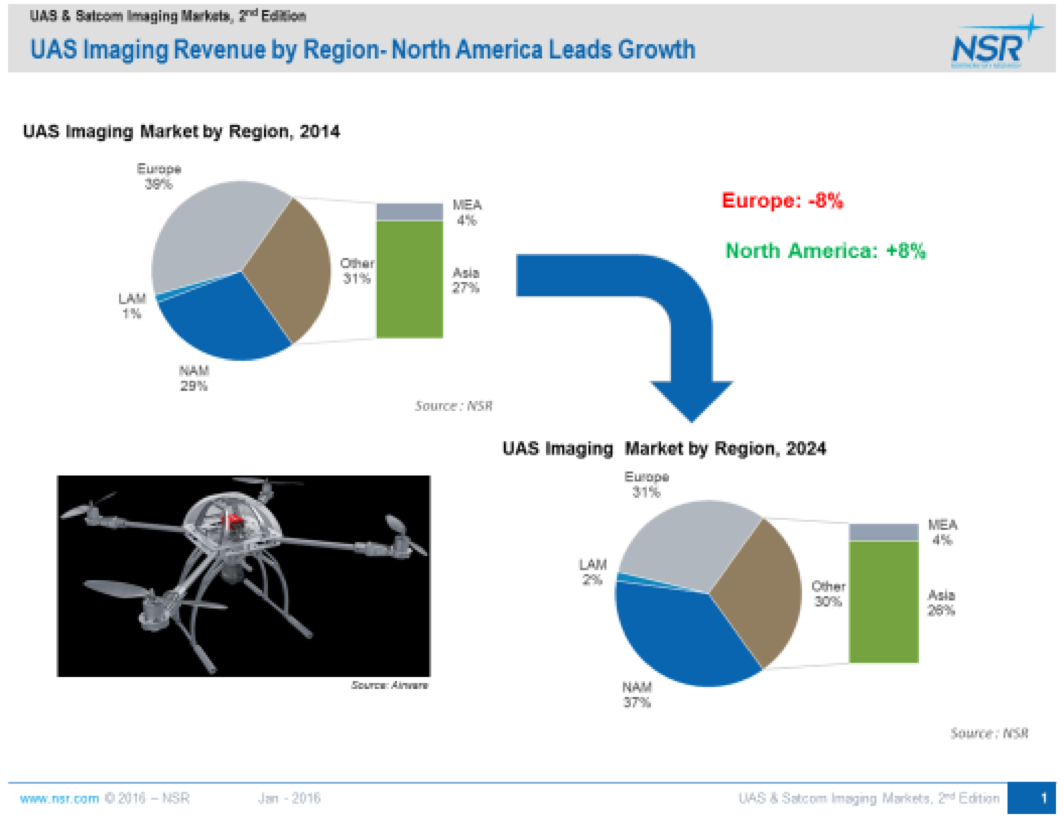| |
The Force is Strong with sUAS
Jan 7th, 2016
by Prateep Basu, NSR
The small UAS (sUAS) industry has grown
rapidly since 2012, from being a hobbyist activity to a full-fledged
commercial industry. At the beginning of 2015, there were only about a
dozen companies that had been approved to fly drones commercially in the
U.S. But within a year, that number has skyrocketed up to
2,500+ approved exemptions under
Section 333 of the FAA,
reflecting the effects of strong lobbying by various industry bodies.
As the U.S. commercial UAS industry awaits a much-delayed regulatory
framework from the FAA, European countries, led by France, have
leapfrogged in this domain by supporting firms through well-defined
regulations and public-private programs such as the Project SUNNY.
According to CB Insights, $172
million was invested in 2015 alone
(an increase of 300% from 2013), with China’s
DJI leading the pack at a $10 billion valuation and $75 million from
Accel Partners.

This industry’s technology refresh rate, both in the hardware
capabilities and software architectures, makes it difficult to analyze
where the market will be 10 years from now. Hence, in NSR’s UAS Satcom &
Imaging Markets, 2nd Edition, we looked at a set of
commercial UAS applications that are driving growth in this sector.
Imaging via UAS was found to be
by far the most promising area of growth for the industry and forecasted
for a 10-year period, as other
propositions like small cargo delivery (Amazon, Google working on it,
while DHL operationalized it last year) remain embattled in regulatory
roadblocks.
The rapid convergence of sUAS technology, consumer electronics, and
computing power has made image analytics the core of UAS-as-a-service
market. Companies like Redbird and Measure focus on providing customized
turnkey solutions in vertical markets such as agriculture, natural
resource management, and energy, to name a few. As the payloads, image
processing software capabilities, and endurance of these machines
improve, the cost of imaging will also come down. Unlike the general
perception, the total cost of
image acquisition and processing via UAS is more expensive than
satellites currently, but
with the added value proposition of providing sharp images up to 1 cm
resolution, which is not possible with satellites.
However, the biggest hurdle for the
commercial UAS imaging industry to mature is also is biggest strength –
its low barrier to entry. The
industry is highly fragmented across the globe, with no real
standardization in both hardware and the operating system. As the
hardware portion is rapidly commoditized, firms like Precision Hawk,
DJI, and Airware are currently trying to address the software part of
the puzzle. The challenges for doing so are the application-specific
requirements – a UAS that fits the bill for agricultural farm monitoring
may not be the best solution for entertainment and media applications.
NSR expects the trend of venture capital infusion in this industry to
accelerate the process of building strategic regional partnerships, with
many M&As to have better control of the UAS-as-a-service value chain.
NSR projected the UAS imaging market (excludes manufacturers revenues)
to grow from close to $200
million in 2015 to over $540 million in 2024.
The North American UAS imaging market is
expected to overtake the European region during this time period,
largely due to a greater addressable market, strong industry growth
fueled by well-funded UAS companies, availability of air traffic
management solutions, and a robust regulatory regime.

Bottom Line
The impetus on data-driven decision making
is a sign of a bright future for the commercial UAS imaging industry, as
it continues innovating to reduce the time and cost of image processing,
while trying to enhance the end-value for the customers.
NSR expects
the increment in stability,
endurance, reliability, and processing power of UAS hardware, coupled
with sophistication in payloads over time, to be key factors for this
sector’s success and growth.
Despite regulatory logjams, the acceptability of sUAS for imaging
purposes in both developed and developing countries by commercial
entities and public authorities is a clear indication that the force
is strong with them.
|
|
 |